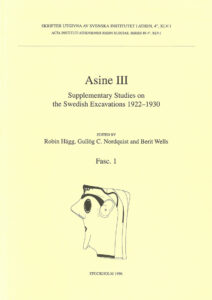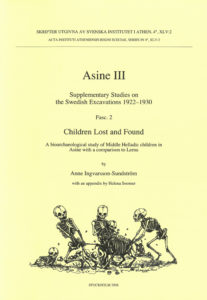Asine 3. Supplementary studies in the Swedish excavations 1922–1930
 Fasc. 1. Supplementary studies in the Swedish excavations 1922–1930
Fasc. 1. Supplementary studies in the Swedish excavations 1922–1930
Edited by Robin Hägg, Gullög C. Nordquist & Berit Wells
Published by the Swedish Institute at Athens. Distributed by Astrom Editions.
This is a collection of eleven papers inaugurating a new series of supplementary studies on the material from the old Swedish excavations at Asine. The first is a summary of the work undertaken between 1922 and 1930 and is intended to help in the study of the published reports and of the unpublished documentation. In further papers additional information is given on the Middle Helladic graves of the Lower Town, the Late Mycenaean terracotta head called “The Lord of Asine” is re-studied, and pottery and small finds from Mycenaean chamber tombs are discussed, including some technical aspects, such as the use of tin foil on pots. A group of Mycenaean vases from the village of Zafer Aga is published for the first time. Another paper deals with the animal bones from the Lower town of Asine. Finally, a concordance of the numbers of the graves and skeletons found at Asine is given as a tool for scholars who wish to work on this material.
Contents
Preface
Gullög C. Nordquist & Robin Hägg, ‘The history of the Asine excavations and collections, with a bibliography’.
Gullög C. Nordquist, ‘New information on old graves’.
Anna Lucia D’Agata, ‘The “Lord” of Asine reconsidered: technique, type and chronology’.
P.A. Mountjoy, ‘Asine Chamber Tomb I:1: the pottery’.
Helen Hughes-Brock, ‘Asine Chamber Tomb I:1: the small finds’.
O.H. Krzyszkowska, ‘Asine Chamber Tomb I:1: the ivories’.
Curt W. Beck, ‘Spectroscopic indentification of “amber” and “black resin” from Asine’.
Carole Gillis, ‘Tin at Asine’.
Birgitta Leppänen Sjöberg, ‘Five Mycenaean vases from Zafer Aga, 1924’.
Katrin Moberg Nilsson, ‘Animal bones from Terrace III in the Lower Town of Asine’.
Gullög C. Nordquist, ‘Grave concordance, Asine 1922–1930’.
Bibliographical information
Robin Hägg, Gullög C. Nordquist & Berit Wells, eds., Asine III. Supplementary studies on the Swedish excavations 1922–1930. Fasc. 1 (Skrifter utgivna av Svenska institutet i Athen, 4°, 45:1), Stockholm 1996. Soft cover, 119 pp. ISSN: 0586-0539. ISBN: 978-91-7916-032-6.
 Fasc. 2. Children lost and found. A bioarchaeological study of Middle Helladic children in Asine with a comparison to Lerna
Fasc. 2. Children lost and found. A bioarchaeological study of Middle Helladic children in Asine with a comparison to Lerna
Open access, use link below. Printed edition available for purchase at Amazon.com, Amazon.de, Bokus.com, Adlibris.com. Distributed by Eddy.se AB.
This study focuses on children’s living conditions during the Middle Helladic period in Greece. The primary material comprises disarticulated skeletal remains found in a stratigraphic context during the Swedish excavations of Asine in 1926: 4,583 fragments/complete bones. These made up 103 subadults and 36 adults by means of Minimum Number of Individual (MNI) calculations. It was possible to assign subadult skeletal remains to 39 of the 105 already published graves in the Lower Town of Asine. In addition, children’s graves and skeletal remains from the neighbouring site of Lerna (periods IV–VI) are considered for comparisons of demography, health and mortuary treatment. The wider archaeological context, i.e., the published mortuary material from the settlements and cemeteries, is also examined and used to describe the community’s perception of children.
It is necessary to consider children in past cultures as active and constantly changing individuals, possessing different social roles during the course of their life. Given that a culture’s perception and definition of children are dependent on age or physical development, for example, the physical remains of these individuals must be given adequate attention; only by including these data also can one hypothesise on a culture’s image of a child as well as on their age specific morbidity and mortality. I argue that neonatals, and even fetuses were regarded as individuals who were afforded the same type of mortuary treatment as older children and adults in the intramural cemetery of Asine. However, it is likely that the elite groups of the community had other customs, possibly preventing the burial of fetuses and neonatals in the extramural cemetery used by them.
The examination of children’s growth and analysis of the teeth suggest that their morbidity was aggravated by periods of malnutrition at both sites. The presence of prenatal disturbances on the teeth combined with normal length of the long bones during the infants’ first months points in different directions: it is therefore likely that different types of physiological stress affected different parts of the skeleton during the individuals’ development. The skeletal growth profiles of children indicate that growth started to be affected after three months of age, and after two years of age many children could probably be considered short for their age in comparison with modern Western children. The neonatal mortality at both Asine and Lerna was probably increased by women’s poor health which seems to have begun already in childhood.
Significant amounts of foods other than breast-milk were probably given to the infants at around four months of age, as reflected by the Bourgeois-Pichat biometric analysis. Demographic variables derived from contemporary pre-industrial populations suggest that older siblings were likely to have been important care-givers for infants and young children, a practice which would also be consistent with an early introduction of other nutrients than breast milk.
Download PDF - Size: 1.74 MB - Downloads: 74 (since 2023)
Bibliographical information
Anne Ingvarsson-Sundström, Asine 3. Supplementary studies in the Swedish excavations 1922–1930. Fasc. 2. Children Lost and Found. A bioarchaeological study of Middle Helladic children in Asine with a comparison to Lerna (Skrifter utgivna av Svenska Institutet i Athen, 4°, 45:2), Stockholm 2008. ISSN 0586-0539. ISBN 978-91-7916-056-2. Soft cover: 153 pages.
Reviews
American Journal of Archaeology 114:3, 2010 (Marshall Joseph Becker)
Bryn Mawr Classical Review 2010.04.26 (Sevi Triantaphyllou)
Revue Archéologique 2, 333-335 (Maia Pomadère)

No Comments
Comments are closed.